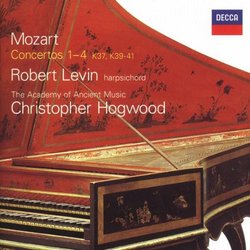| All Artists: Wolfgang Amadeus Mozart, Christopher Hogwood, Academy of Ancient Music, Robert Levin Title: Mozart: Keyboard Concertos Nos. 1-4 - K. 37, 39, 40, 41 Members Wishing: 1 Total Copies: 0 Label: Decca Release Date: 4/10/2001 Genres: Alternative Rock, Rock, Classical, Classic Rock, Metal Styles: Hardcore & Punk, Historical Periods, Classical (c.1770-1830), Instruments, Keyboard, Symphonies, Album-Oriented Rock (AOR), Glam Number of Discs: 1 SwapaCD Credits: 1 UPC: 028946613122 |
Search - Wolfgang Amadeus Mozart, Christopher Hogwood, Academy of Ancient Music :: Mozart: Keyboard Concertos Nos. 1-4 - K. 37, 39, 40, 41
 | Wolfgang Amadeus Mozart, Christopher Hogwood, Academy of Ancient Music Mozart: Keyboard Concertos Nos. 1-4 - K. 37, 39, 40, 41 Genres: Alternative Rock, Rock, Classical, Classic Rock, Metal
|
Larger Image |
CD Details |
CD ReviewsLively performances of rarely heard works Gaja Merovinni | Italy | 04/17/2001 (5 out of 5 stars) "Commonly called the "pasticcio concertos", these works date from 1767 and mostly consist of reworkings, arrangements, expansions, etc. of sonata movements by other composers (whose names will probably sound unfamiliar to most readers: Raupach, Honauer, Shobert, and even C. P. E. Bach), and their importance in Mozart's output, especially given the genius of his maturity concertos, is usually considered to be minimal; their overall atmosphere is a rather "style galant" one, and, as one might expect, quite a far call from the late Mozart. In spite of that, and in spite of Mozart being helped by his father Leopold in the arrangements, these concertos already show some of the young composer's qualities, especially in the sonata form developments (e. g. the minor modulations and some tone nuances which are absent in, let's say, C. P. E. Bach's concertos). Besides, they show an interesting chapter of the creation of the piano concerto as we know it (from its late Mozart and Beethoven archetypes). The (historically informed) performance by Robert Levin is outstandingly accurate and quite rightly centered on improvisation (the cadenzas are improvised, as are the embellishments); following documents about performances Mozart gave of these concertos, he plays on a harpsichord (Bavington modeled after a Goermans-Taskin) whose excellent sound can only be commended. As on most period performances, the harpsichord also gives a quasi-continuo role during the orchestral tuttis. As for the orchestra itself, Hogwood conducts his AAM with elegance, a great sense of colour, and most of all, a certain liveliness which (along with the soloist's talent) is probably the main element in this performance's success. (On a side note, I'd like to spend a few words to confute the anonymous reviewer from Austria: I do not agree with his views of Mozart as a piano composer, but that is a matter of personal taste, I guess; much more importantly, I dare praying the kind reader to consider the inconsistencies contained in his review, for as harpsichord keys are generally black, the term ivory is quite inappropriate to describe them. The very instrument he knows as piano is commonly called a harpsichord, clavecin, gravicembolo, etc.)." Beautiful Sanja Kostic | mirro | 05/20/2006 (5 out of 5 stars) "One who doesn't have this CD, could be well informed about the CD from Peter Branscombe's review, though, I would like to add my personal impression, hopping that it will help potential buyer to buy this precious music.
To the subject, now. I'd change that CD opens with Concerto No.3. It is so explosive in "Allegro", beginning with underlined accord ("tam,tam, tam")- forte, which makes so big importance to the thematic material that follows. Then, it elaborates contrasting two themes, in Mozart's original manner being not less brilliant than any latter works. Then, "Andante" bright, with a good, constant tempo and almost no development (a measure or two), just to let people take the breath before the final movement. "Presto" is music of C.P.E Bach but elevated to the Mozart's genius. The orchestral introduction, which starts with a furious, upward passage, built in crescendo to the climax, makes the energized ambience before the cembalo takes up, playing the same role. It is fast and furious till the very end. Violins, lead by Andrew Manze are vivid and meticulously articulated, plus punctual timpani and trumpets, it all makes the theatrical ambience throughout. But, the most amazing are horns. They are so greatly amuseing that I got the impression that they really enjoyed their orchestral score made it to be their own solos- What a charming orchestra! The rest of the CD is pure Mozart, concertos not less worth than any other of his works. I really enjoy listening to this music. Oh!-I almost missed to mention "Andante Staccato" of the Concerto No.2. In a way, it is a "Holly Relic", an endless music, latter seen in a "Andante" of Clavier-Concerto No.22 that I could indulge for hours repeating it again and again. I also honor cembalo, oboes and flutes for this remakrable music. Mirro" |

 Track Listings (12) - Disc #1
Track Listings (12) - Disc #1